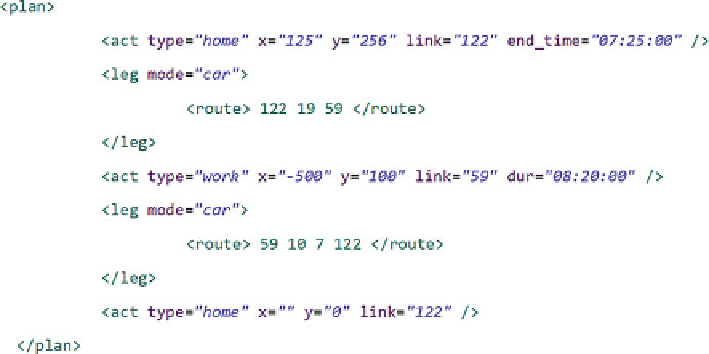Geoscience Reference
In-Depth Information
The plan also contains information about the road (link), where the home and
work activities are located, and the route (link ids) the agent wants to drive. The
micro-simulation in MATSim follows the instructions in the plan and executes it
step by step. This means that the agent leaves home at the time specified in the plan
and, thereafter, is routed through a virtual road network throughout the day. As an
agent's vehicle is typically not traveling alone on the road network, interactions with
other vehicles and road capacity constraints come into play. While the simulation
is running, information about the performance of the plan is also collected. For
example, did the agent need to pay a toll, how long was the travel time, and how
long did the agent work? This information is used to calculate different
utility
components for the various aspects of the plan. These are added up during the
scoring
step, such that each executed plan has a score assigned to it. The next
step in the iteration is called
replanning.
In this step, either an old plan, which was
generated in a previous iteration, is reselected for execution in the next iteration or a
new plan is generated, possibly by adapting a previous plan. This allows alternative
choices for the agent such as the mode of travel or the travel route. Often, the
probability of reselecting a plan for execution in the next iteration is based on its
score, meaning that a plan with a higher score has a higher chance of reselection.
Due to memory limitations, only a small number of plans are kept, and the plan with
the lowest score is deleted whenever a new plan is generated. This corresponds to
mutation, selection, and survival of the fittest within the context of evolutionary
algorithms (Holland
1992
). As this iterative process continues, the plans of the
agents become more and more optimized, which is reflected by the improvement
of the utility score of the agents over time. This score improvement flattens out after
a certain number of iterations, depending on the choice dimensions available to the
agents. This is interpreted as a situation, which is close to user equilibrium, and is
called optimized/relaxed demand.

Search WWH ::

Custom Search